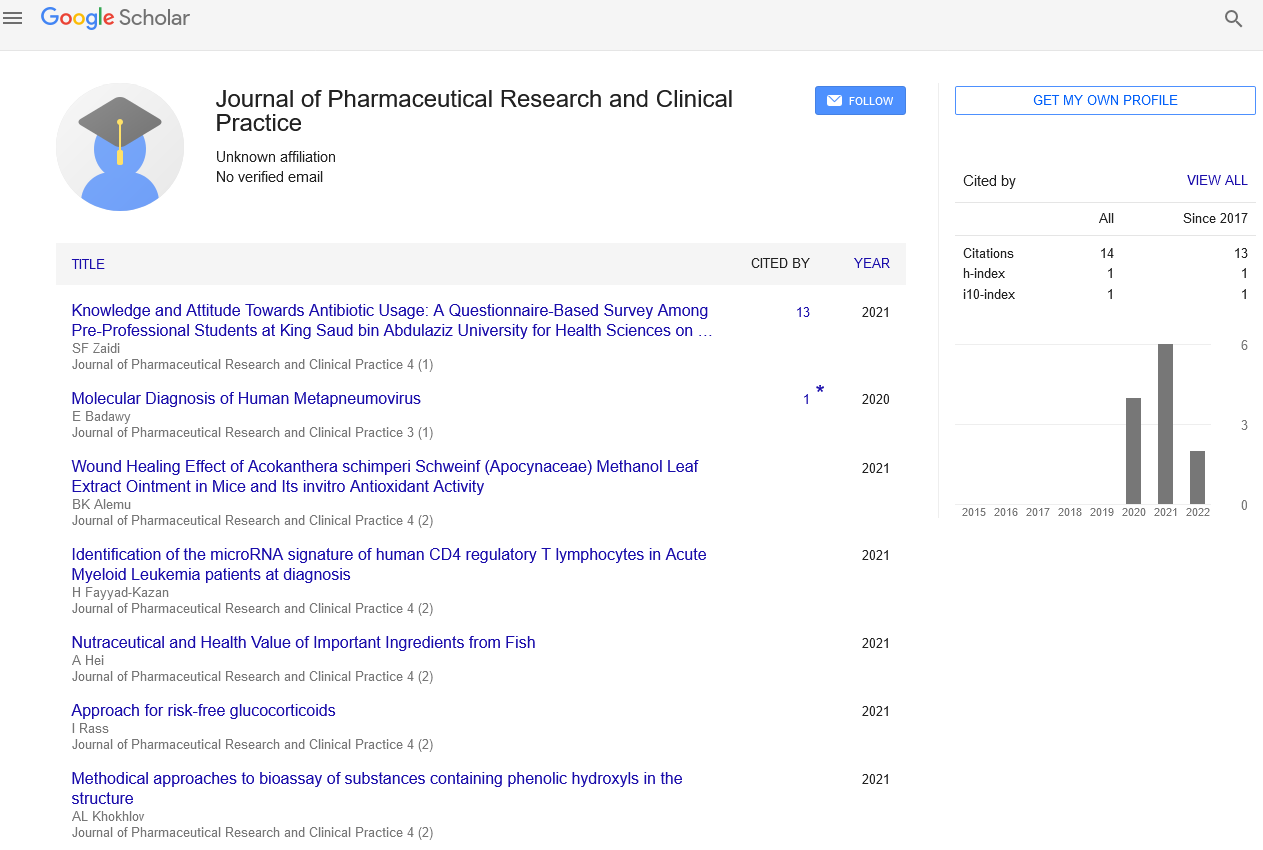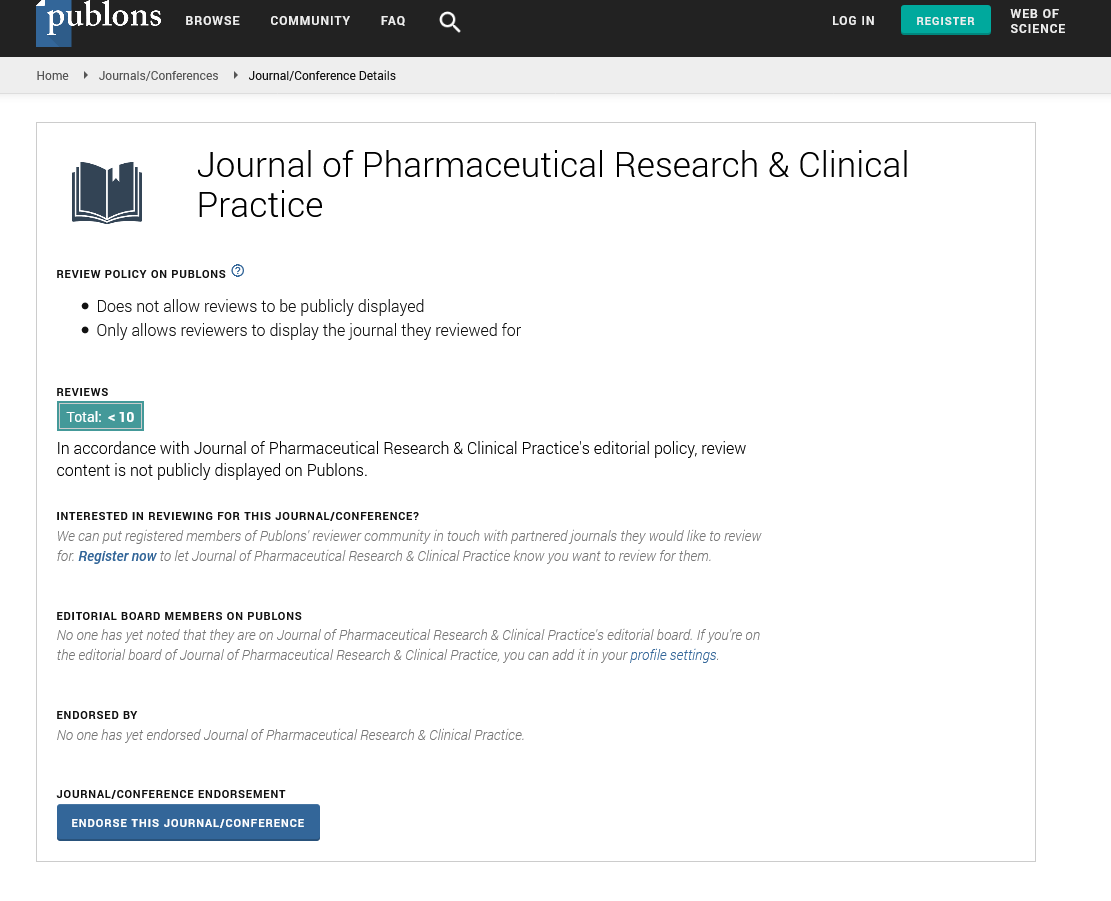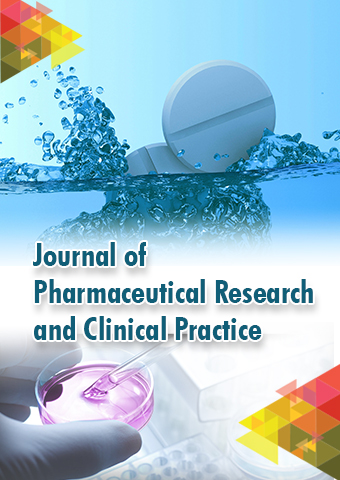Case Report - Journal of Pharmaceutical Research and Clinical Practice (2023) Volume 6, Issue 1
A Case Report on Cardiovascular Enlargement and Linked Disorder in Down Patients With symptoms
Rajvika Paul*
Department of Internal Medicine, Hyogo College of Medicine, Sasayama Medical Center, Sasayama 669-2321, Hyogo, Japan
Department of Internal Medicine, Hyogo College of Medicine, Sasayama Medical Center, Sasayama 669-2321, Hyogo, Japan
E-mail: Rajvika_paul@gmail.com
Received: 01- February- 2023, Manuscript No. jprcp-23-88936; Editor assigned: 03- February- 2023, PreQC No. jprcp-23-88936 (PQ); Reviewed: 17- February- 2023, QC No. jprcp-23-88936; Revised: 22- February- 2023, Manuscript No. jprcp-23-88936 (R); Published: 28-February- 2023 ; DOI: 10.37532/ jprcp.2023.6(1).10-12
Abstract
The availability of appropriate pharmaceutical and surgical treatments has significantly increased the survival rate of adrenal Cushing syndrome patients. Nevertheless, a significant risk factor for the survival of affected patients is the increased likelihood of a heart attack brought on by a cardiovascular event. Through glucocorticoid receptor activation, it has been demonstrated in experimental studies that hypercortisolemia causes cardiomyocyte hypertrophy. This includes the possibility of cross talk between several cardiomyocyte-related hypertrophy signals and the tissue-dependent regulation of 11-hydroxysteroid dehydrogenase type 1. In clinical cases, however, the factors are more complex because both geometric and functional impairments that lead to heart failure have been discovered. These impairments are crucially associated with a wide range of factors, such as hypertension. Also, very little is known about these changes in autonomous cortisol secretion, which have a high risk of causing heart attacks and overt Cushing syndrome. While functional disorders are contentious when considering the effects of treatment, partial improvement of structural alterations is anticipated. As a result, it is still unclear whether normalizing excessive cortisol reduces the risk of cardiac hypertrophy
Keywords
Adrenal tumor • Autonomous cortisol secretion • Cardiac functional disorder • Cardiac hypertrophy • Cardio myocytes • Cushing syndrome • Glucocorticoid excess • Surgery • Mortality
Introduction
As a normal history of Cushing syndrome (CS), 50% of affected patients have died within five years of diagnosis since Harvey Cushing first reported a 23-year-old woman with a pituitary adenoma in 1910, primarily due to a cardiovascular event that caused a heart attack. Numerous studies on early diagnosis and appropriate treatment have been conducted. Some small-scale studies have shown that patients with CS have a relative long-term mortality rate that is comparable to that of the general population (within five to seven years) after treatment. However, diagnostic delay remains a serious problem, and a number of studies have shown that even after successful treatment, the survival rate of CS patients is reduced. A large-scale population study, in particular, found a higher rate of life-threatening events like heart attacks, with a standardized mortality ratio of 3.0 (95% CI: 2.4–3.7) among 1127 benign adrenal CS patients [1].
Subclinical adrenal CS, which exhibits autonomous excess cortisol secretion without observable physical characteristics that are related, has received attention since the 1990s. This pathophysiology was named “autonomous cortisol secretion (ACS)” and “possible (p) ACS” in a 2016 European Society of Endocrinology Clinical Practice Guideline. ACS showed >138 nmol/L (>5.0 g/dL) and pACS 51–138 nmol/L (1.9–5.0 g/dL), respectively, in a 1-mg dexamethasone test (DST). These conditions share the same spectrum. In addition to overt CS, pathophysiological differences have also been taken into account, and it has been demonstrated that these pathological conditions are associated with an increased risk of diabetes mellitus, hypertension, and heart attack-inducing cardiovascular events. The somatic mutation of PRKACA, which encodes the catalytic subunit of cyclic adenosine monophosphate (cAMP)-dependent protein kinase (PKA), is common in overt adrenal CS (35–66%) cases, but uncommon in ACS (11%). For instance, approximately twothirds of cases of ACS do not progress into overt CS. Inherent differences in genetic background have been revealed [2].
A well-known condition that suggests the possibility of ACS caused by hypercortisolemia is cardiac hypertrophy. Because of its connection to the onset of heart failure and cardiac death, early detection of this change can result in an earlier diagnosis and help cut mortality. However, there aren’t many reviews of the related experimental mechanisms or clinical characteristics of hypercortisolemia in the literature. The purpose of this study was to summarize the effects of therapeutic interventions on cardiac impairment in affected patients and to provide an updated review of findings from both experimental and clinical medicine investigations demonstrating the influence of excessive cortisol on heart structure and function [3].
Discussion
After connecting to a glucocorticoid (GC) receptor (GR) or mineralocorticoid receptor (MR), bioactive cortisol, which is produced in the adrenal cortex, exerts its effects. Three functional domains make up the nuclear receptor superfamily of ligand-dependent transcription factors that includes GR: a central DNAbinding domain (DBD), a C-terminal ligandbinding domain (LBD), and an N-terminal transactivation domain (NTD). GR is present in nearly all human tissues and organs and functions as a multiprotein complex in the cytoplasm. After the complex, which includes heat shock protein 90, is dissociated by cortisol binding, GC signaling enhances genomic and rapid non-genomic effects [4]. MR is also a member of the ligand-dependent transcription factor nuclear receptor superfamily and shares a structural similarity with GR. It induces genomic and rapid non-genomic effects in the same way as GR does, though the outcome is significantly different from that of GR activation and limited localization has been demonstrated, such as in cortical collecting ducts, the epithelium of the large intestine and the cerebrum, the endothelium of blood vessels, and cardiac Despite the fact that both cortisol and aldosterone can act as MR ligands, cortisol has a higher affinity for MR and a blood concentration that is 100 to 1000 times higher than aldosterone’s. Additionally, cortisol may exhibit both agonist and antagonist MR properties [5, 6]. However, in a rat heart failure model, it was demonstrated that GC acts as an MR agonist, and MR transcription is rarely activated without stress or tissue injury [7, 8]. Left ventricular hypertrophy (LVH), a known risk factor for myocardial ischemia and the development of heart failure, is a common finding in echocardiographic studies of patients with overt CS. Despite the small population, Sugihara et al. examined 12 patients, ages 27 to 57; nine with adrenal CS, eight females and four males) with overt CS and provided suggestive results. At end-diastole, nine of those patients had LVH with an IVST diameter of more than 15 millimeters (mean standard deviation, 17.8 6.2 millimetres), which was more severe than in patients with essential hypertension (n = 53, 11.5 2.9 millimetres, p 0.01) or primary aldosteronism (n = 8, 11.3 1.2 millimetres, p 0.01). It is interesting to note that the posterior wall thickness (PWT) diameter at end-diastole was relatively low in all groups (11.3% in the CS group, 10.4% in the essential hypertension group, and 10.8% in the primary aldosterone’s group) [9]. In addition, only the CS group had an IVST/PWT ratio that was significantly higher than 1.3, indicating that asymmetric sepal hypertrophy (ASH) was already present. Disproportional hypertrophy of this kind is uncommon in cases of secondary hypertensive disease as well as essential hypertension, such as Reno-vascular hypertension (91,92), primary aldosterone’s (92), and pheochromocytoma (93). The increased rate of regional stress has been suggested as a possible mechanism for this structural change [10].
Conclusion
In conclusion, it has been demonstrated experimentally that elevated cortisol causes cardiomyocyte hypertrophy via activated GC signalling through GR. Human pathophysiology, on the other hand, is more complicated, indicating associations with a variety of factors, including hypertension. According to the findings of this literature review, a hypertensive state may exacerbate LVH in CS patients, but this may be contingent, at least in part, on its duration or severity. Additionally, impairments in systolic and diastolic function were found to be independently associated with both hypertension and CS. After normalizing excess cortisol, partial improvement of structural alterations is anticipated when considering treatment, but the possibility of improvements in functional disorders remains contentious.
The evidence presented in this review strongly demonstrates that hypercortisolemia itself has a relationship with geometric and/or functional alterations, as shown in clinical results as well as experimental findings. However, it remains unclear to what extent these findings are related to mortality of patients with overt CS or ACS. Nevertheless, the results of this investigation necessitate evaluations of the effects of treatment on long-term mortality and additional clarification regarding whether such changes in pre-symptomatic state contribute to early diagnosis of hypercortisolemia.
Acknowledgement
None
Conflict of Interest
None
References
- Hill-Taylor B, Walsh KA, Stewart S et al. Effectiveness of the STOPP/START (Screening Tool of Older Persons’ potentially inappropriate Prescriptions/Screening Tool to Alert doctors to the Right Treatment) criteria: Systematic review and meta-analysis of randomized controlled studies.J. Clin. Pharm. Ther.41, 158–169(2016).
- Tommelein E, Mehuys E, Petrovic M et al. Potentially inappropriate prescribing in community-dwelling older people across Europe: A systematic literature review.Eur. J. Clin. Pharmacol.71, 1415–1427.
- Sadozai L, Sable S, Le E Roux et al. International consensus validation of the POPI tool (Pediatrics: Omission of Prescriptions and Inappropriate prescriptions) to identify inappropriate prescribing in pediatrics.PLoS ONE.15, 47-72 (2018).
- Barry E, Moriarty F, Boland F et al. The PIPc Study-application of indicators of potentially inappropriate prescribing in children (PIPc) to a national prescribing database in Ireland: A cross-sectional prevalence study.BMJ Open.8, 69-556 (2019).
- Al-Badri A. Almuqbali J, Al-Rahbi K et al. A Study of the Paediatric Prescriptions at the Tertiary Care Hospital in Oman.J. Pharmaceut. Res.5, 17-56(2020)
- Al-Maqbali, Haridass S, Hassali M et al. Analysis of Pediatric Outpatient Prescriptions in a Polyclinic of Oman. Glob.J. Med. Res.19, 2249–4618(2019).
- Cullinan S, O’Mahony D, Fleming A et al. A meta-synthesis of potentially inappropriate prescribing in older patients.Drugs Aging.31, 631–638(2014).
- Liew TM, Lee CS, Goh Shawn KL et al. Potentially Inappropriate Prescribing Among Older Persons: A Meta-Analysis of Observational Studies.Ann. Fam. Med.17, 257–266(2019).
- Heberer T. Occurrence, fate, and removal of pharmaceutical residues in the aquatic environment: A review recent research data. Toxicol. Lett. 131, 5-17 (2002).
- Banci L, Ciofi-Baffoni S, Tien M Lignin et al. Peroxidase-catalyzed oxidation of phenolic lignin oligomers. Biochemistry. 38, 3205-3210 (1999).
Indexed at, Google Scholar, Crossref
Indexed at, Google Scholar, Crossref
Indexed at, Google Scholar, Crossref


